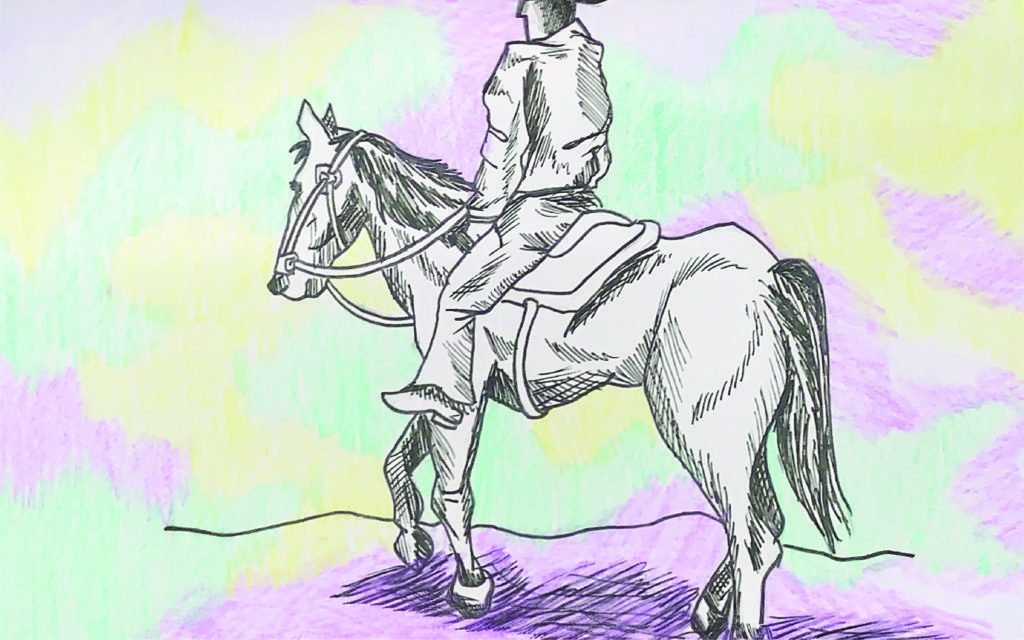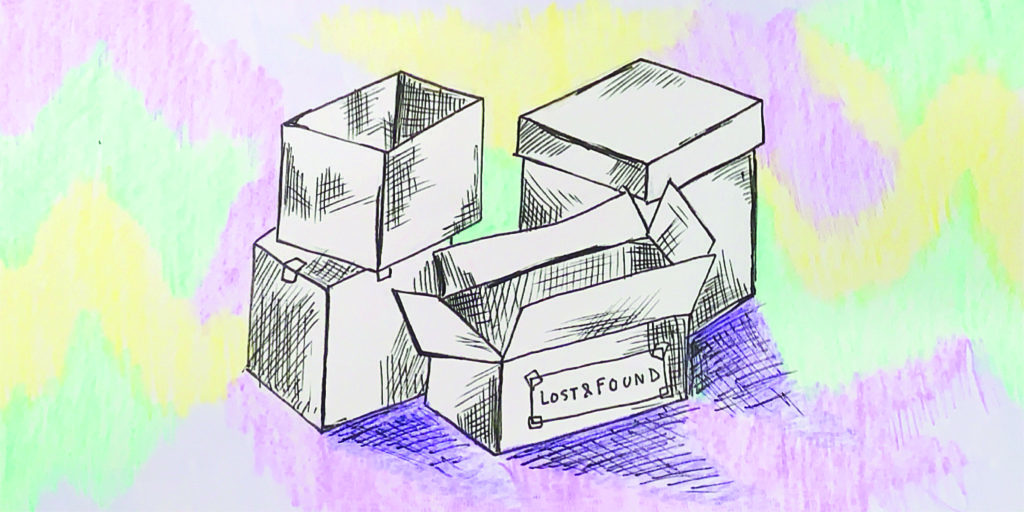Nate still hadn’t returned to the campsite. As the sunlight faded behind the mountains, the cool shadows creeping down their slopes, I pictured the clothes he had been wearing: a cotton t-shirt and baggy shorts, with strappy Chacos for footwear — the uniform of a male college student. In my down jacket, I shivered. A May night at 9,000 feet in the air would be cold.
The word “lost” had echoed in my thoughts, ever since another student came to me an hour before to say, “Hey, should we be worried about Nate?” Seven of them had gone out for a short hike away from the campground in the middle of the warm day. No one mentioned at first that only six had returned. They thought, like I did when I first found out, that he would wander into camp at any moment, the antler sheds he’d been searching for hooked over a shoulder. But now, two hours later, he still hadn’t returned.
“Yes, we should worry,” I muttered, recalling there was no cell service, and calculated how little daylight was left. Some of the students volunteered to search the trail, but I didn’t want anyone else gone from my sight. I walked the loop that connected the campsites. I looked up the trail the students had hiked as if just being present could call Nate out of the steep woods.
I pictured trying to explain my student’s disappearance to the President of the college. And how I couldn’t tell him that if I’d had to pick a student to lose, it would have been this troublesome one. The day before we left campus in our 15-passenger van, Nate had proposed driving his own car so he could smoke while driving. He hadn’t liked my insistence that we all travel together, but the thought that he could die under my watch was all too real. I should have had a plan. I should have made the hikers use a buddy system. But I’m a college professor, not an Outward-Bound instructor. I don’t usually have to worry about students falling off cliffs or wandering down the wrong drainage.
We were camped in the Valle Vidal, “The Valley of Life,” a remote part of the Carson National Forest in northern New Mexico — it was my third year leading a field school in cultural anthropology. We’d come here to help Michael Casados, a seventh-generation New Mexican, to reconstruct the irrigation ditch on a historic ranch property. In nearby San Luis, the oldest town in Colorado, we’d been learning about the communal irrigation system called acequias, as part of the field school activities. This campsite had been our next stop after our extended stay in San Luis.
After we worked with Michael earlier in the day, he’d drive back to his home outside the Valle. We would set up our tents in this rustic campground with a few other early-season campers, most of them with their horses because the high grassy meadows were known for their endless riding trails. I’d already struck up a conversation with the cowboys from Oklahoma who’d come to the area to ride amongst Ted Turner’s runaway buffalo. They had seen a buffalo calf earlier and helped the rangers herd it and some other buffalo back toward Turner’s two-million-acre ranch to the north. I hadn’t known about Nate then.
My hands stuffed into my pockets, I returned to their campsite as it began to get dark. “Hey,” I said to the guy named Bo, “I’m not sure what to do. One of my students still hasn’t come back from hiking, and the others have been back about three hours now.” I knew I had waited too long.
Bo was brisk, sizing up the situation. “Don’t you worry about a thing, ma’am,” he told me. “We’ll ride out after him.” He called to his friends, gathered his gear, and quizzed me about Nate at the same time. I pictured the buffalo the cowboys had been herding and thought my student was the same—he needed to be reunited with the herd, and the Oklahomans were equally enthused for this new task.
It wasn’t long before the four of them were saddled up and had set out on the trail. “Nate! Nate!” I heard in their comforting drawl, the sounds retreating into the darkening wood along with bouncing lights from their headlamps. I said a little prayer. I was now responsible for the safety and whereabouts of four more people.

It was from my mother I inherited the belief that people have guardian angels, and I tried to concentrate on that idea. I remembered my daughter, as a toddler, lost in a big box store in California, and how I’d found her hiding out below a circular clothes rack, playing hide and seek. I thought of my mom and dad traveling through Europe in a Volkswagen van with their four kids. How we all had set out on our own once we reached Paris, or Madrid, still managed to get back to our campground, and the van, without the use of cell phones or tracking devices. How no disaster had ever befallen us. I thought of how Bryan had found me in the highlands of Bolivia, just a reckless wannabe boyfriend, even though he was on a bicycle and only had the name of my small village from a letter I’d written him.
The divorce from my husband, Rafael, had been finalized just weeks before I set out for the remote altiplano to conduct research, forgetting about my cheating husband in one lonely swoop. Or that was the plan. To put distance between the two of us — and his pregnant girlfriend. I thought immersion in another culture would help mend my heart, but I hadn’t known how much time I would have to grieve or how often I’d think of what I’d lost. I pictured my ex-husband; at the Egyptian restaurant in Minneapolis we used to love, the radio station where he worked, and with our friends. After about six months into my fieldwork, I wondered whether his baby had been born. Boy or girl?
I didn’t write to Bryan during that first year in Bolivia. He was the last guy I’d dated before Rafael, and I knew the letter I’d eventually write would reveal my divorce, and sound like an invitation. I waited, gathering my strength. Still, he would later tell me I seemed lost in that dusty village — and it wasn’t just the location. The so-called anthropological fieldwork —digging potatoes with neighbors, attending weddings and fiestas, hanging out with vendors in the marketplace — didn’t prevent the recognition that I hadn’t shed the sadness, not by a long shot.
Bryan’s appearance at my Bolivian home wasn’t just thrilling, it had made me feel confident in the balance of being lost and found. But now standing in the dark in the Valle Vidal I also wondered if I — or rather, Nate — was about to pay the price for my previous good luck in the lost and found department.
A truck pulled into the campground, and I watched it loop the one-way road, a horse trailer in tow. It came to a stop at our site, and Nate hopped down from the passenger seat. The students whooped. Not sure whether to hug or shake him, I went to thank the driver instead, who’d found my student five miles away, walking along the road. As Nate recounted, he’d kept walking down the trail after he realized he’d missed the turnoff to the campground, calculating he would eventually come to the road.
“Do you know how many people have been worrying about you, looking for you?” I said, not able to give in to the warm relief flooding my system.
“I wasn’t lost,” he told me. “I was just on a different trail.”
Before I could figure out how to counter his Zen-like description, the cowboys were returning through the dark trees on their horses, having been called in by the other students.
“Where is this Nate?” one said. “I want to see what his face looks like because I reckon, he ain’t got no common sense.” Unremorsefully, Nate was spirited off to the Oklahomans’ campsite, so they could have a man-to-man talk with him. I crawled into my own tent and wrapped myself in my sleeping bag. It took me a long time to warm up.
When Bryan appeared that day at the door of my adobe patio, I had no inkling he was on his way. The second letter I’d written to encourage his plans to visit had been sent just a week or so before. But I didn’t know then he’d already landed in Santiago, Chile, and begun the bike trek to find me. As he neared my Bolivian home, a Señora out herding her sheep had found him riding his mountain bike up the rocky road, and correctly guessed that this rare gringo must be looking for the village gringa. She showed up at my door with a flock of 50 sheep and Bryan, sheepish and grinning, with her. This is how my future husband won my heart. The image of him standing there with sheep swirling around him is still enough to calm the urge I have — a restless nomad — to move on to new pastures when things get difficult between my husband of 20 years and me.
The next day the cowboys told me they’d grilled a little chipmunk meat during their talk around the campfire and had “invited” Nate to try some. I’m pretty sure there was whisky to wash it down. I gave up trying to scold Nate, realizing our neighbors had done it for me. In the van leaving the Valle Vidal, Nate told us about the entire night at the campfire, and how the guys from Oklahoma had called him “Lost Boy.” The name stuck, and for the rest of the trip the other students called him the same. “Where’s Lost Boy?” one of them would say. “Uh-oh,” was the usual response. Instead of chafing at this, Nate embraced his new nickname. Only someone who’s been well and truly lost can appreciate the gift of being found. •




